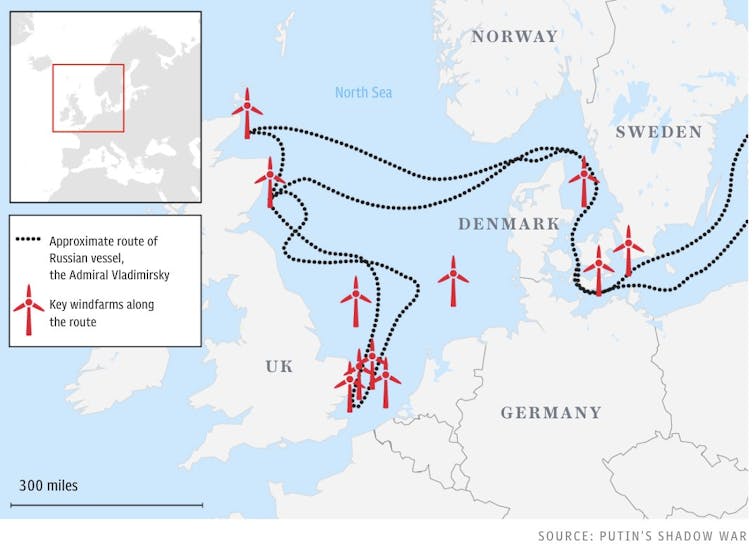A new documentary produced by a consortium of public broadcasters in Sweden, Denmark, Finland and Norway has revealed what appears to be a profound threat to maritime and undersea energy and data infrastructure in the North Sea and the Baltic region. The Shadow War includes footage of a Russian research vessel called Admiral Vladimirsky allegedly collecting data on windfarms, gas pipelines, power and internet cables.
The film, which has been widely reported in the UK press this week, asserts that Russia is systematically mapping the vulnerabilities of maritime infrastructure in the North Sea. This would enable Russia to learn of any weak spots – for instance, the locations where underwater energy and data cables intersect, making it easier to mount a sabotage attack if the Kremlin deemed it necessary.
These reports don’t tell maritime security experts anything they don’t already know. We have known for a long time that Russian forces are mapping maritime infrastructures, including wind farms, communication cables and pipelines. Indeed, back in the 1990s and 2000s, when Nato and Russia were cooperating on some security issues, Russian spying activities in Nordic waters never stopped. In 2013, I was taken on a Royal Navy vessel to the North Sea where part of its mission was to look out for Russian spy ships.
But since the occupation of Crimea by Russia in 2014 these activities have intensified. Across European waters, including in Irish and Portuguese waters and the Mediterranean, Russian vessels have been spotted conducting intelligence operations.
Nord Stream sabotage
The sabotage of the Nord Stream gas pipeline in September 2022, in which a core energy pipeline was destroyed in the Baltic Sea, raised significant concerns in the west about the damage a hostile power could do by destroying or disrupting this important energy or information infrastructure.
The culprit behind the Nord Stream sabotage has not yet been identified. But the latest reports show that these worries are justified.
Nord Stream pipeline sabotage: how an attack could have been carried out and why Europe was defenceless
Nato and the EU have rolled out ambitious plans for improving the resilience of maritime infrastructure. Nato and the EU created new working groups and coordination bodies to develop better protection strategies and coordinate between civil and military agencies. In March of this year, the European Commission published an ambitious action plan as part of the updated EU maritime security strategy. It foresees studies to identify the most severe vulnerabilities and better surveillance. But do these plans go far enough?
Why the North Sea is so significant
The gas and oil supplies of the North Sea are an important resource for the entire European energy market. The increasing focus on the production of green energy makes this strategic importance even greater. More than 40 windfarms are based in the region, and with ideal conditions for wind energy, installations are continuously and rapidly expanding. The North Sea is hence vital to reduce dependency on fossil fuels and lower CO₂ emissions.

The Shadow War
But given what we now suspect about Russian intelligence and possible sabotage activities, the North Sea now needs to be seen as a vulnerable and critical strategic security space. A concerted act of sabotage, damaging underwater electricity cables, for instance, can do significant harm to energy markets. Cutting underwater data cables can limit internet connectivity including across the Atlantic, since important data cable connect for instance Denmark and the US. Repair at sea is costly as it requires specialised ships, which can only operate if the weather conditions allow. After all the North Sea is a harsh environment.
Recent Nato and EU initiatives centre on improving surveillance. They aim at getting better at detecting suspicious activities, such as those reported by the Nordic documentary film. Satellites, radar and patrols – including by unmanned vehicles – CCTV on all infrastructure and contributions by maritime users, such as fishermen who report suspicious activity, can do much to improve the overall awareness.
This can assist in rapid responses and can also be a deterrent. Information sharing between states and with the industry is important. Nato, the EU, the UK and Norway need to work closely together, as none of them can handle this on their own. Putting different sources of information together to identify suspicious patterns is needed.
Importance of rapid repair
What often gets too little attention is the question of repair. If an attack occurs, it is vital to be able to fix any damage as quickly as possible in order to return to normal. Not only that, but if there is a demonstrable repair capacity in the region it reduces the strategic value – and hence the likelihood – of such an attack.
But as of now, these key repair capacities – such as specialised repair vessels and cable depots are severely limited in Europe.
New models of how security policy and the industry can work together to develop strategic repair capacities are required. These might be public-private partnerships that operate repair ships and provide contingency for crisis situations. This would have the dual benefit of enhancing repair capacity and, perhaps, at the same time will give an opportunity to enhance the efficiency of infrastructure by reducing repair times in the North Sea and elsewhere more generally.




